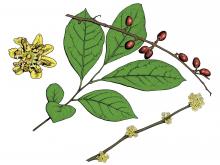Trees, Shrubs and Woody Vines
Media

Species Types
Scientific Name
Cercis canadensis
Description
Eastern redbud is a native shrub or small tree that is distinctly ornamental in spring with small, clustered, rose-purple flowers covering the bare branches before the leaves.
Media

Species Types
Scientific Name
Juniperus virginiana
Description
By far the most common native conifer in the state, eastern red cedar is useful for its aromatic, red wood and beloved for its greenery, its resinous blue “berries,” and the spicy odor it lends the outdoors.
Media

Species Types
Scientific Name
Lonicera maackii (Amur) and Lonicera x bella (bella)
Description
If there’s a giant green thicket in your woods, you may have a bush honeysuckle infestation. These invasive plants are shrubby natives of Asia. In America, where they have no natural controls, they leaf out early, grow fast, spread fast, and form dense thickets that crowd out native forest plants.
Media

Species Types
Scientific Name
Various species in the genus Crataegus
Description
Our state flower, the hawthorn, is solidly represented in Missouri. There are about 100 different kinds of hawthorns that occupy almost every kind of soil in every part of the state. These members of the rose family are closely related to apples.
Media

Species Types
Scientific Name
Ilex decidua
Description
Possum haw, or deciduous holly, is the more common of two native Missouri hollies that lose their leaves each fall. This shrub or small tree is eye-catching in the fall and winter with its bright red berries.
Media

Species Types
Scientific Name
Viburnum prunifolium
Description
Black haw is a small understory tree with beautiful fall color — deep lavender or maroon-purple, finally becoming deep rose-red. Its clusters of blue-black berries, borne on red stalks, happen to be quite tasty. No wonder it has been cultivated as an ornamental since 1727!
Media

Species Types
Scientific Name
Malus ioensis
Description
Prairie crab apple is an attractive, small, ornamental tree with low, crooked branches and attractive spring flowers. Its hard, bitter fruits can be used in making tasty jellies, cider, and vinegar.
Media

Species Types
Scientific Name
Lindera benzoin
Description
Spicebush is a stout, smooth, aromatic shrub of the damp woods. Its eye-catching, early-blooming flowers and its bright red fruits make it a popular native ornamental for shade gardens.
Media

Species Types
Scientific Name
Salix spp. (about 12 species in Missouri)
Description
Exotic willows are available at lawn and garden centers, but there are several willow species that are native to Missouri. Most are rather humble colonizers of gravel bars, riverbanks, and lakesides. Many are important for human economic interests. All have a place in our wild ecosystems.
Media

Species Types
Scientific Name
Asimina triloba
Description
“Way down yonder in the pawpaw patch” is an old song you might be familiar with — but today, surprisingly few Missourians know a pawpaw tree when they see one. This is a good tree to know, especially when the large, sweet fruit are ripening!
See Also
About Trees, Shrubs and Woody Vines in Missouri
There are no sharp dividing lines between trees, shrubs, and woody vines, or even between woody and nonwoody plants. “Wood” is a type of tissue made of cellulose and lignin that many plants develop as they mature — whether they are “woody” or not. Trees are woody plants over 13 feet tall with a single trunk. Shrubs are less than 13 feet tall, with multiple stems. Vines require support or else sprawl over the ground.





















